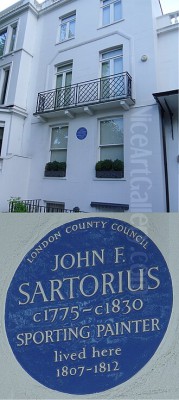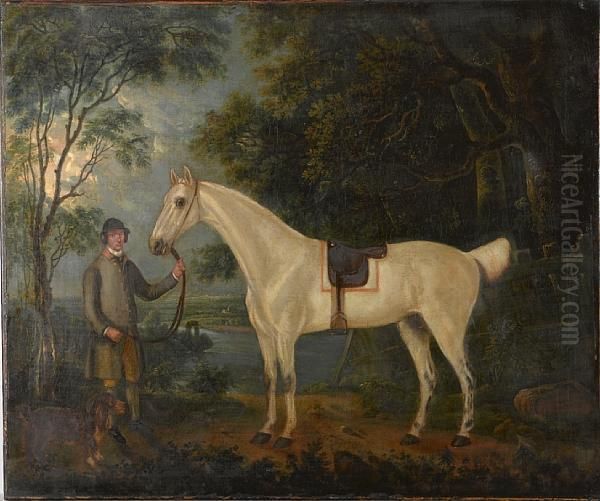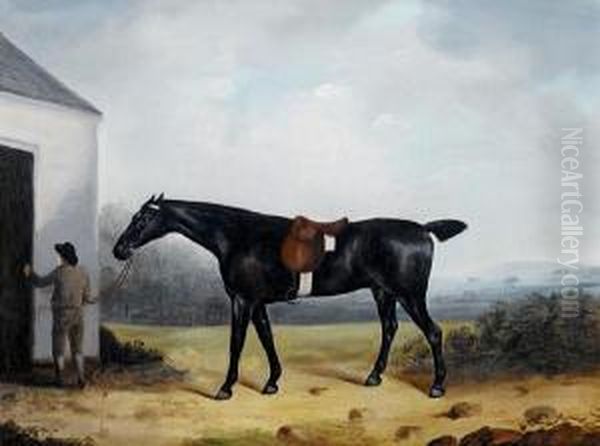
J. Francis Sartorius stands as a notable figure within the rich tradition of British sporting art. Active during the late 18th and early 19th centuries, he dedicated his career to capturing the dynamic energy and refined elegance of equestrian pursuits, particularly hunting and horse racing. Born into a lineage already distinguished in the art world, Sartorius carved his own niche, becoming a respected painter whose works were sought after by the landed gentry and sporting enthusiasts of his day. Based primarily in London, his art provides a valuable window into the pastimes and passions of British society during a period of significant cultural development.
A Legacy in Art: The Sartorius Dynasty
The name Sartorius resonates within the history of British animal and sporting painting. J. Francis Sartorius was part of a multi-generational family of artists who specialized in these popular themes. The dynasty's artistic roots can be traced back to his grandfather, Francis Sartorius (c. 1700-1780), who established the family's reputation. The tradition was carried on by J. Francis's father, John Francis Sartorius (c. 1734-1780), who further cemented the family name in artistic circles.
J. Francis (1755-1828), the subject of this discussion, continued this legacy, working alongside his arguably more famous brother, John Nost Sartorius (1759-1828). Both brothers became prolific painters of horses, hounds, and the thrill of the chase. This strong family background undoubtedly provided an immersive environment steeped in the techniques and subjects of sporting art, influencing J. Francis's own development as a painter, even if specific details of his training remain elusive. The Sartorius family, across generations, became synonymous with reliable, well-executed depictions of British sporting life.
Life and Artistic Career

Born in the bustling heart of London, England, J. Francis Sartorius was inherently British in his nationality and artistic focus. His lifespan (1755-1828) placed him firmly within the Georgian era, a time when sporting pursuits were gaining increasing prominence and patronage among the upper classes. London served as the primary hub for his activities throughout his life. Records indicate he maintained studios at various addresses in the city, including Wells Street, Oxford Street, and later at 109 St. Martin's Lane, reflecting an active professional career within the capital's art scene.
Sartorius was a regular contributor to the prestigious exhibitions held at the Royal Academy of Arts in London. His works were displayed there over a significant period, from 1781 to 1824. This consistent presence at the Academy underscores his recognition within the established art world and provided a crucial platform for reaching potential patrons. Beyond London, his reputation extended further, with evidence suggesting his works were also exhibited in various counties across Ireland, indicating a broader reach and appeal for his specialized subject matter. His career was characterized by a dedicated focus on the sporting themes that defined his family's artistic identity.
Artistic Style and Thematic Focus
J. Francis Sartorius worked squarely within the tradition of British sporting painting. His style is generally characterized as traditional, demonstrating a commitment to accurate representation, particularly in the rendering of horses and hounds, which were central to his work. He possessed a keen eye for animal anatomy and movement, capturing the grace of horses at rest or the dynamic energy of a hunt in full flow. His compositions often feature detailed landscape settings, providing context for the equestrian activities depicted and showcasing an appreciation for the British countryside.
His technique involved careful brushwork, often employing softer tones and fluid lines, contributing to an overall sense of elegance that appealed to his clientele. While perhaps lacking the profound anatomical depth of his contemporary George Stubbs, Sartorius's work possesses a distinct charm, sometimes described as having a slightly idealized or naive quality, yet always grounded in observational accuracy. He excelled at narrative scenes, particularly the hunt, capturing the sequence of events from the gathering of riders to the intensity of the chase. Light and colour are handled competently, serving to highlight the main subjects and create atmospheric settings, whether it be a stable interior or an open field.

The primary themes explored by Sartorius were intrinsically linked to the lifestyle of the British gentry. Fox hunting, horse racing, and portraiture of favoured steeds and hounds dominated his output. These subjects were not merely decorative; they reflected the social status, leisure activities, and passions of his patrons. His ability to capture both the likeness of specific animals and the spirit of these sporting events made him a popular choice for commissions. His work serves as a visual record of these pursuits, rendered with skill and an evident appreciation for the subject matter.
Representative Works
Among J. Francis Sartorius's body of work, several paintings stand out as representative of his style and thematic interests. One frequently cited example is Full Cry. This title typically refers to a hunting scene at its peak intensity, depicting hounds and riders in hot pursuit of their quarry across the landscape. Such works showcase Sartorius's ability to handle complex compositions with multiple figures, both human and animal, conveying a sense of speed, excitement, and coordinated action inherent in the hunt. These paintings capture the vibrant energy and social dynamics of a traditional British fox hunt.
Another work mentioned is Two Carriages Horses in a Stable. This piece likely represents a quieter, more focused study of equine subjects. Stable scenes allowed artists to concentrate on the form and presence of the horses themselves, often highlighting their grooming, musculature, and individual characteristics. It demonstrates Sartorius's skill in animal portraiture, capturing the specific likeness and temperament of the horses within the familiar setting of their stable environment. Such paintings appealed to owners proud of their valuable carriage horses.
It is also noted that a famous image of the racehorse Eclipse was based on a sketch by his father, Francis Sartorius. This highlights the intergenerational connections and potential collaborations or shared resources within the Sartorius family's artistic practice. While J. Francis painted numerous equestrian portraits and racing scenes himself, this specific instance points to the foundational work laid by his predecessors. These examples illustrate the range within his sporting specialization, from dynamic field action to more composed animal studies.
Context within British Sporting Art
J. Francis Sartorius practiced his art during a flourishing period for sporting painting in Britain. The 18th century saw a significant rise in demand for depictions of horse racing, hunting, shooting, and other countryside pursuits, driven by aristocratic and gentry patronage. Sartorius and his family were key contributors to this genre, building upon the foundations laid by earlier pioneers like John Wootton, James Seymour, and Peter Tillemans, who first popularized these themes in British art.

He worked contemporaneously with some of the most significant figures in the field. The preeminent animal painter of the era was undoubtedly George Stubbs, whose rigorous anatomical studies and sophisticated compositions set a high benchmark. While Sartorius's work may not display the same level of scientific inquiry as Stubbs, it offered a readily accessible and pleasing style. Other notable contemporaries included Sawrey Gilpin, also known for his sensitive horse portraits and dramatic animal subjects, and Benjamin Marshall, who brought a vigorous realism, particularly to racing scenes. Philip Reinagle was another versatile artist of the time, known for sporting subjects, animal painting, and landscapes.
The Sartorius family, including J. Francis and his brother John Nost Sartorius, occupied a solid position within this artistic landscape. They were perhaps less innovative than Stubbs or Marshall but were highly productive and reliable, fulfilling a consistent demand for sporting pictures. Their work was widely disseminated, not only through original canvases but likely also through prints, which helped popularize sporting imagery. Patrons like Sir Walter Gilbey, a noted collector mentioned in relation to J. Francis, played a crucial role in supporting artists specializing in these themes. The tradition continued strongly into the 19th century with artists such as Henry Alken, famous for his lively hunting and coaching prints, James Pollard, specializing in coaching and racing incidents, and the highly successful John Frederick Herring Sr., renowned for his detailed portraits of racehorses. Even portraitists like Sir Francis Grant, later President of the Royal Academy, occasionally engaged with sporting subjects, indicating the genre's enduring appeal.
Education and Artistic Training
Specific details regarding the formal education of J. Francis Sartorius are not well-documented in readily available sources. There is no definitive record confirming his attendance at a specific art academy or apprenticeship under a master outside his own family. However, given the strong artistic tradition within the Sartorius family, it is highly probable that his primary training occurred within this familial context. Learning the craft directly from his father, John Francis Sartorius, or alongside his brother, John Nost, would have been a conventional path for an artist's son in the 18th century.
This form of workshop-based training would involve instruction in drawing, mixing colours, composition, and the specific techniques required for animal and landscape painting. His consistent exhibition record at the Royal Academy from 1781 suggests he achieved a level of proficiency recognized by the art establishment, whether through formal schooling or dedicated self-teaching and family guidance. The specialized nature of sporting art, requiring detailed knowledge of animal anatomy and the nuances of equestrian activities, often fostered dedicated lineages of artists, like the Sartorius and Herring families, where skills were passed down through generations. While we cannot confirm formal academic training, his accomplished output clearly indicates a thorough grounding in the principles and practices of painting prevalent in his time.
Legacy and Reputation
J. Francis Sartorius occupies a respected place within the annals of British sporting art. While perhaps overshadowed in critical acclaim by the towering figure of George Stubbs or the later popularity of artists like Herring or Alken, Sartorius was a significant and prolific contributor to the genre during his lifetime. His work faithfully documents the sporting pastimes of the British gentry in the late Georgian period, providing valuable historical insight as well as aesthetic pleasure.
His reputation was built on his reliability and skill in capturing the specific likenesses of horses and hounds, as well as the atmosphere of the hunt and the racecourse. The consistent demand for his work and his long exhibiting history at the Royal Academy attest to his contemporary success. Collectors like Sir Walter Gilbey recognized the quality and appeal of his paintings. Though his style adhered to the established conventions of sporting art rather than breaking new ground, its traditional qualities and competent execution ensured its popularity.
Today, works by J. Francis Sartorius are held in various public and private collections, particularly those specializing in British art and sporting history. His paintings continue to be appreciated by enthusiasts of equestrian art for their detailed observation, period charm, and evocative portrayal of a bygone era of country life. He remains an important member of the Sartorius dynasty, representing a family whose collective output significantly shaped the visual culture of British sport.
Conclusion
J. Francis Sartorius was a dedicated and skilled practitioner of sporting art, contributing significantly to this popular genre in late 18th and early 19th-century Britain. As a member of the distinguished Sartorius family of artists, he inherited and perpetuated a tradition focused on the depiction of horses, hounds, and the activities of hunting and racing. Working primarily in London and exhibiting regularly at the Royal Academy, he achieved considerable recognition during his lifetime. His paintings, characterized by careful observation, traditional technique, and an evident understanding of his subject matter, offer enduring visual records of British sporting life and continue to be valued by collectors and art historians today.